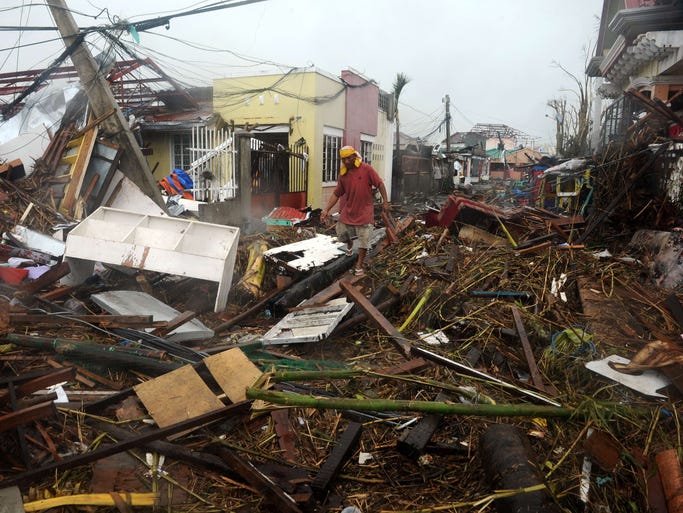Official: Over 10000 feared dead in Typhoon Haiyan
MANILA — As many as 10,000 people are feared dead in one city alone after Super Typhoon Haiyan — one of the most powerful storms ever recorded — slammed into the central islands of the Philippines, officials said.
Regional police chief Elmer Soria said he was briefed by Leyte provincial Gov. Dominic Petilla late Saturday and told there were about 10,000 deaths on the island, mostly by drowning and from collapsed buildings. The governor’s figure was based on reports from village officials in areas where Typhoon Haiyan slammed Friday.
Tacloban city administrator Tecson Lim said that the death toll in the city “could go up to 10,000.” A mass burial was planned Sunday in Palo town near Tacloban.
Interior Secretary Mar Roxas said a massive rescue operation was underway. “We expect a very high number of fatalities as well as injured,” Roxas said after visiting Tacloban on Saturday.
Reports also trickled in from elsewhere on the island, and from neighboring islands, indicating hundreds, if not thousands more deaths, though it will be days before the full extent of the storm’s impact can be assessed.
On Samar Island, which is facing Tacloban, Leo Dacaynos of the provincial disaster office said Sunday that 300 people were confirmed dead in Basey town and another 2,000 are missing.
He said that the storm surge caused sea waters to rise 20 feet when Typhoon Haiyan hit Friday, before crossing to Tacloban.
There are still other towns on Samar that have not been reached, he said, and appealed for food and water. Power was knocked out and there was no cellphone signal, making communication possible only by radio.
President Benigno Aquino III flew around Leyte by helicopter on Sunday and landed in Tacloban to get a firsthand look at the disaster. He said the government’s priority was to restore power and communications in isolated areas and deliver relief and medical assistance to victims.
Defense Secretary Voltaire Gazmin said Aquino was “speechless” when he told him of the devastation the typhoon had wrought in Tacloban.
“I told him all systems are down,” Gazmin said. “There is no power, no water, nothing. People are desperate. They’re looting.”
Vice Mayor Jim Pe of Coron town on Busuanga, the last island battered by the typhoon before it blew away to the South China Sea, said most of the houses and buildings there had been destroyed or damaged. Five people drowned in the storm surge and three others were missing, he said by phone.
If the typhoon death toll is confirmed, it would be the deadliest natural catastrophe on record in the Philippines. The deadliest typhoon before Haiyan was Tropical Storm Thelma in November 1991, which killed around 5,100 people in the central Philippines. The deadliest disaster so far was the 1976 magnitude-7.9 earthquake that triggered a tsunami in the Moro Gulf in the southern Philippines, killing 5,791 people.
The storm weakened Sunday to 103 mph with stronger gusts and was forecast to loose strength further when it hits northern Vietnam’s Thanh Hoa province early Monday morning.
As Haiyan heads west toward Vietnam, the Red Cross is at the forefront of an international effort to provide food, water, shelter and other relief to the hundreds of thousands of Philippines residents who have lost their homes and livelihood, Richard Gordon, CEO of the Philippine Red Cross, said.
“This is a big, full-court press,” he said. “We’re pulling out all the stops to help.”
UNICEF’s supply division in Copenhagen was loading 60 metric tons of relief supplies for an emergency airlift expected to arrive in the Philippines on Tuesday.
With widespread power outages, roads blocked, bridges down and debris strewn everywhere, getting life back to some semblance of normal in the region will take time.
“The Philippines are always resilient, and we’re going to get back up,” Gordon said.
STORY: Why is Philippines a hot zone for typhoons?
STORY: U.S. aid on the way to devastated areas of Philippines
STORY: How you can help Typhoon Haiyan survivors
Anna Lindenfors, Philippines director of Save the Children, said officials in the country were still trying to gather information about the damage caused by Typhoon Haiyan. As of Saturday, communication lines to the hardest-hit areas had yet to be re-established, she said.
“With this magnitude, we know that the destruction is overwhelming,” said Emma Amores, who was waiting outside Villamor Airbase in Manila, where a C-130 was loading relief supplies and personnel heading to hard-hit Tacloban. “From the images we saw on TV, it’s highly likely our houses are gone. We just want to know that the family are all safe.”

Romil Elinsuv, who is in Manila for work training, worried about his wife and 4-year-old son, who are at their home in Palo, a town in the province of Leyte.
“I feel fear. I don’t know what the situation is there,” Elinsuv said. He said he spoke with his wife the day before. She assured him they were OK, but then the line went dead, and he’s been unable to reach her since.
Super Typhoon Haiyan hit Guiuan, on the Philippine island of Samar, at 4:40 a.m. local time Friday. Three hours before landfall, the Joint Typhoon Warning Center assessed Haiyan’s sustained winds at 195 mph, gusting to 235 mph, making it the fourth-strongest tropical cyclone in world history.
Source: USA Today